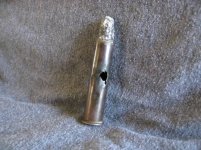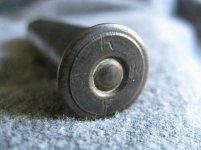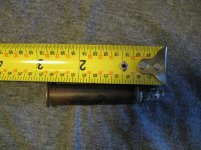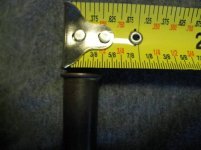You are using an out of date browser. It may not display this or other websites correctly.
You should upgrade or use an alternative browser.
You should upgrade or use an alternative browser.
45-70 headstamp
- Thread starter wally76
- Start date
Longhair
Elite Member
It could also be .43Spanish, or one of the similar 11mm rounds. Actual measurements are the only way to tell for sure, unless you find specific reference to the headstamp.
Silversmith45
Elite Member
Looks like a Krag round.
turtlefoot
Headstamp Addict
I don't know about the caliber but your headstamp is a very early Frankford Arsenal headstamp. The numbers are the dates of manufacture. 5 84 will be May 1884.
Here is a link to another one that is similar.
http://www.acwbullets.com/Y835.htm
Nice find!
Doug
Here is a link to another one that is similar.
http://www.acwbullets.com/Y835.htm
Nice find!
Doug
Last edited:
I don't know about the caliber but your headstamp is a very early Frankfrod Arsenal headstamp. The numbers are the dates of manufacture. 5 84 will be May 1884.
Here is a link to another one that is similar.
http://www.acwbullets.com/Y835.htm
Nice find!
Doug
Big thanks turtlefoot. I should have put a question mark after 45-70 because it was my uncles guess that thats what it was. So i guess it is old, thanks again.
turtlefoot
Headstamp Addict
Here is a great pic of an original box that explains the headstamp. It tells you what each letter and number stand for.
Doug

Doug
Voriax
Forum Supporter
What is the exact length of a case? If it's 53mm then it is likely a 45-70, but there are couple other possibilities. Also the rim diameter would be useful..sorry but I don't consider tape measure accurate in these cases 
Voriax

Voriax
45-70 rounds
I was given about 40 or more of these same rounds, I was searching and found this forum. The R & F are the same but the dates are different. They do measure 53mm long. And are the exact measurements of my modern 45-70's. But mine are corroded and the primer has been used but the lead is still in the bullet. I thought that was kind of strange. Everyone is like that. Kind of like a misfire where the primer is struck but doesn't go off.
Does anybody know anything about these?
I was glad to find this forum with this topic.
I was given about 40 or more of these same rounds, I was searching and found this forum. The R & F are the same but the dates are different. They do measure 53mm long. And are the exact measurements of my modern 45-70's. But mine are corroded and the primer has been used but the lead is still in the bullet. I thought that was kind of strange. Everyone is like that. Kind of like a misfire where the primer is struck but doesn't go off.
Does anybody know anything about these?
I was glad to find this forum with this topic.
Looks about like 45-70, got a box of live rounds some place. There was also a 45-90, not sure about the difference. My dad had the rifle, and it kicked like a mule. The rife got stolen, but I saved a box. Think I'm missing one though. Have to dig through some boxes, but will post some pictures in a day or two.
turtlefoot
Headstamp Addict
I was given about 40 or more of these same rounds, I was searching and found this forum. The R & F are the same but the dates are different. They do measure 53mm long. And are the exact measurements of my modern 45-70's. But mine are corroded and the primer has been used but the lead is still in the bullet. I thought that was kind of strange. Everyone is like that. Kind of like a misfire where the primer is struck but doesn't go off.
Does anybody know anything about these?
I was glad to find this forum with this topic.
That's a strange one! I would love to see some pics of the ones that you have. The .45-70 is one of my favorite "historic" rifle rounds. Welcome to the forum by the way. Looking forward to hearing more from you.
Doug
Longhair
Elite Member
A light strike can rupture the anvil inside the primer w/o detonating, and the round becomes useless at that point. The original 1873 Trapdoor Springfields were notorious for it. The Allen conversion took care of the problem.I was given about 40 or more of these same rounds, I was searching and found this forum. The R & F are the same but the dates are different. They do measure 53mm long. And are the exact measurements of my modern 45-70's. But mine are corroded and the primer has been used but the lead is still in the bullet. I thought that was kind of strange. Everyone is like that. Kind of like a misfire where the primer is struck but doesn't go off.
Does anybody know anything about these?
I was glad to find this forum with this topic.
turtlefoot
Headstamp Addict
A light strike can rupture the anvil inside the primer w/o detonating, and the round becomes useless at that point. The original 1873 Trapdoor Springfields were notorious for it. The Allen conversion took care of the problem.
Thanks for the info Longhair. I have that info in my files now. I appreciate it.
Doug





